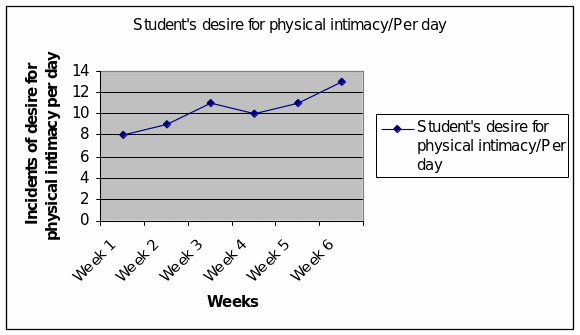The aim of this report is to identify a specific behavioral problem for the case study client in question, and applying social work intervention using the single subject research design to promote his overall well-being. The activity details a targeted negative behavior that got reduced for the client with the aid of the worker, through a 6-week intervention phase, which is followed by a resulting conclusion.
The client is a 9 year old African-American male student in the third grade who attends Columbus Magnet Elementary School. He lives with his mother and two siblings in a three bedroom house in a low-income neighborhood in Norwalk, Connecticut. The student’s parents have been divorced for five years and he has limited contact with the father.
Suffering from Attention Deficit Hyperactivity Disorder (ADHD) and Other Health Impaired (OHI), the student has developed an inappropriate fondness for hugging, hand-holding and constant cuddling with adults. He was referred to the Social Work Department by his teacher because of her growing concern about the inappropriate touching he engages in with everyone.
The single-system design (B design) has been chosen to address the problem because of various advantages it offers including the client being given full control over the problem (albeit after articulation by the social worker), immediate feedback, realistic, measurable goals and standardized outcomes (Salahu-Din, 2003, p.321).
A visual analysis of data for applied single-system design has shown that with this method, children with learning disabilities and classroom behavioral problems show observable positive changes over a period of time (Dupper, 2002, p.322). The method incorporates identifying a targeted behavior to be reduced followed by repeat collection of information on a single system over a period of time (Salahu-Din, 2003, p.322). The objective is to find progress through a system of client self-reports, process recordings, observations and interviews (Salahu-Din, 2003, p.322).
The targeted behavior in this case was quantified as the frequency and intensity with which the student expressed his desire to be physically intimate with adults during a six hour time duration. At baseline level, the practitioner found it to be 2-3 times an hour, for about 1-2 minutes or 12-18 times every school day, the average of which is taken as 15 times per day. The impact of the behavior is such that it interferes with academic learning for this student and his peers.
Any treatment for this problem must clearly demonstrate, with hard data, that interventions led to a clear reduction in the student’s propensity to continue with the behavior (Dupper, 2002, p.221). In the design state of the intervention, the practitioner decided to implement a solution-focused therapy which usually runs for five or ten sessions (in this case, six sessions) which simply assesses changes over a period of time (Dupper, 2002, p. 221).
During this, the practitioner counseled the student to slightly modify his behavior according to the solution-focused therapy approach which meant each time he felt the urge to hug or cuddle someone, he would be required to ask for their permission. The student’s success in this activity was directly tied to a reward system which included among many things, the chance to pick a game with friends during lunch time or playing a game on the computer. The reward-based system is a proven behavior modification tool in single system design-based interventions (Grinnell & Williams, 1990, p.247).
At the same time, the student was allowed to continue with other activities including bi-weekly counseling with social worker, medication therapy with family doctor and other outside medical interventions. The data for monitoring student progress is based on bi-weekly teacher interviews, student self-reports (using a note diary) and bi-weekly counseling sessions with the worker.
The weekly progress of the student’s desire for physical intimacy from a baseline average of 15/per day is shown below (also, refer the graph as attached). In the first week, the student’s average came down drastically to 8/day. Such a huge amount of reduction can be attributed to the introduction of a new entertainment tool for the client, who especially if a child, shows significant improvement in their objectionable behavior (Salahu-Din, 2003, p. 325). However, this trend could not continue past the first week into the second week although it went up by only 1 unit.

For next three weeks, the numbers hovered around 10/day and 11/day with the student achieving realistic reduction in the targeted behavior, and should be considered a stabilization of the problem. However, in the final week, the number again rose to 13/day which could be either an outlier, or the student could have shown a tendency to regress to past behavior which basically puts a question mark on whether or not the intervention method was effective enough, and if more intensive intervention may be required to follow suit in the future (Grinnell & Williams, 1990, p.248).
As a probable conclusion to the single subject research design experiment on the student, the practitioner recommends baseline repeat measures of the rewards-based strategy mentioned in the report to resolve the doubt over whether or not the student has achieved realistic progress. If the answer is no, different care intervention strategies will be needed. Single System Design may no longer be appropriate as it is well known that obtaining a sufficiently long baseline does not solve the problem (Salahu-Din, 2003, p. 325).
References
Dupper, D.R. (2002). School Social Work: Skills and Intervention for Effective Practice. John Wiley & Sons: New York.
Grinnell, R.M., & Williams, M. (1990) Research in social work: A primer. Itasca, Itasca, IL.
Salahu-Din, S. (2003). Social Work Research: An Applied Approach. Pearson: New York.